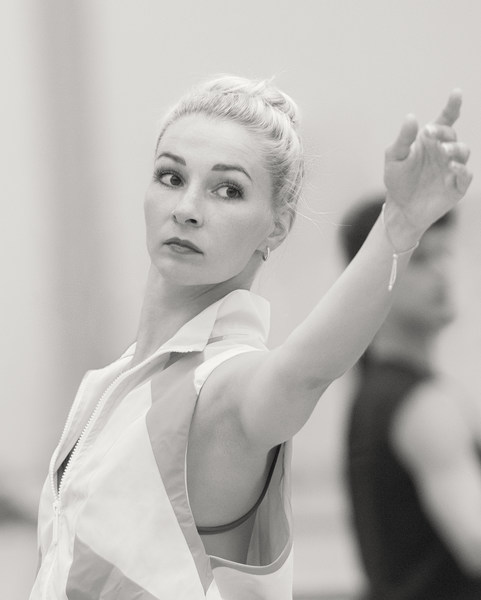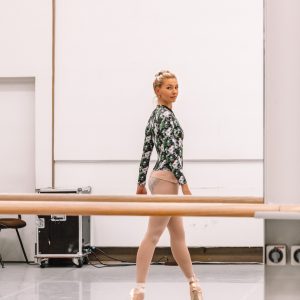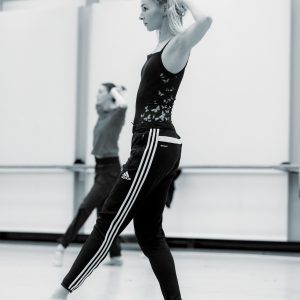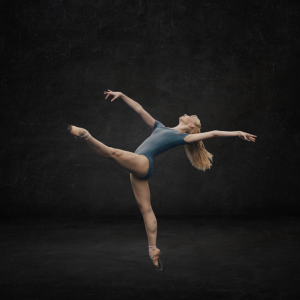
Technology, and the World’s First Worldwide-Accessible Agency for Ballet
Interview with Rebecca Haw – a Ballet Dancer from South Wales
By Rick Tjia
Rebecca Haw is a ballet dancer from South Wales who has had her share of challenges fighting her way to employment in the very difficult and very competitive world of ballet.
But so what, you may say. We’ve heard that story before. Is this not the story of 99% of all the dancers in the ballet industry? Isn’t this story but one among a million others?
It might be, if it weren’t for some remarkable things she’s done. Things that may change the outcome of some—maybe a lot—of those stories.

Rebecca currently dances with Semperoper Dresden, after having lived an all-too-common struggle with the dance market, a struggle that is familiar to way too many dancers. A native of South Wales, she went into vocational training at 14, a bit later than most serious dance students, despite the fact that she had started ballet at the age of two. Attending two schools until her graduation, she auditioned through her graduation year without success, while at the same time holding down several non-dance jobs in order to pay the bills. Then, at a make or break moment— at an audition that she had told herself would be her very last classical audition—she finally landed a two-month contract doing Swan Lake. As it turns out, she stayed on at that company for three and a half years.
A couple years into her first company job (with her director’s blessing), she was back on the audition track. Once again living the struggle of countless unsuccessful auditions, like before, just as she was nearing a personal ultimatum she ended up on a temporary contract with Semperoper Dresden.
A Portrait of the Artist as a Young Brand
Fast forward to 2023. Now entering her seventh year with Semperoper, during which time she also founded a marketing studio business called CODA Digital, she is now celebrating the one-year milestone of her new talent and recruitment agency called CODA, the world’s first agency of the sort centered specifically around classical ballet.
The world’s first talent and recruitment agency for ballet companies and dancers—an innovation in the ballet industry, but a very surprising one because talent agencies themselves have been around for a long time. They are far from new. In fact, the first talent agency dates back to 1898, when the William Morris Agency came into being to service Vaudeville. Talent agencies in Hollywood date back to the 1930’s, and dance agencies in particular serving the musical theater and film industry have been around for decades.
So it is very surprising that the ballet world has never had one. How can this be?
“No one seems to be happy with the current way things work In this area,” she says of the traditional hiring process, “yet they’re terrified of it being changed. For the dancers: it doesn’t work for them. I can speak for myself and the hundreds that I have spoken to over the years. For the employers it also doesn’t seem to work for them.”
She continues. “It is baffling to me, with the technologies of today. You’ve mentioned ‘how is it that in 2022 the first agency is coming about in classical ballet’—even if it was manually done. But why, with the technology that we have today, would we still adopt such a tedious, time consuming, and unfruitful way of doing something? That also blows my mind a little bit.”
So she put two and two together and got CODA.
“Anyone who’s come close to this kind of idea has been scared off by the stubbornness of the industry. Whether that’s people from within it or people from outside who have a little knowledge of being in it and a large knowledge of business. I’ve spoken to people like that, huge entrepreneurs— who wish me luck, because they’re aware of what I was going up against.”
The Wizard of Aaahs

The late Steve Jobs, former CEO and founder of Apple, is known for saying, “Creativity is just connecting things. When you ask a creative person how they did something, they may feel a little guilty because they didn’t really do it, they just saw something. It seemed obvious to them after a while…That’s because they were able to connect experiences they’ve had and synthesize new things.”
American author and former dot com business executive Seth Godin also said something that adds to that: “The magic of connecting dots is that once you learn the techniques, the dots can change but you’ll still be good at connecting them.”
The point being that innovation is most often not about creating something entirely new, but finding a new way of connecting the dots, dots that we did not necessarily create ourselves.
But to do that takes vision, and it is in this regard that Rebecca stands out from the rest—pulling her story from the one among a million that we mentioned before, and making it one in a million instead. Because not only is she taking an age-old agency format and applying it to a new industry, she is doing it through cloud-based apps and processes. For many of us, using cloud apps to improve efficiency is old news, but for the ballet industry it has been typically treated with avoidance.
“One of the huge issues that I had myself but have seen in plenty of others is that traditional auditioning systems weren’t filtered enough,” Rebecca notes. “And so what that means is companies and directors have huge auditions with hundreds, and hundreds of people. It’s long, it’s tedious, and generally unfruitful in the sense that there’s so many candidates and it’s so unfiltered that they’re going to miss opportunities. They’re going to miss dancers, just based on the pure quantity of it.
“On the other side, for dancers particularly…what it means is you end up attending a myriad of auditions that you are not right for and just filtered on the basics of someone glancing at your CV and glancing at some photographs. It doesn’t serve the dancer either, because whilst they might get more auditions, what that actually means is they’re spending three to five hundred quid a pop flying to an audition.
“The bonus of (us) being cloud-based and remote means that whether you’re training in, or an existing professional in California, or Sydney, Australia, or Bordeaux in France, it means that we can keep the selection pool of opportunities from the dancer side quite equal and fair in that sense.”
Case in point: “We have a lot of dancers from Australia already on the books,” says Rebecca.
“What’s interesting is, although Australia is seen as so far away from Europe and from the States, it’s surprising— I think it must come in from a very young age in Australian schools—that whether you stay in Australia or go broader, this broader mindset of possibilities is inherently trained in them. Because in every classical ballet in the world, there’s usually an Australian.”
And we can imagine how much it costs them to travel to even one live audition to get into those companies, let alone several.
So Rebecca noticed a real industry need, acted upon it, and as a result of her research and effort has already had an impact. The CODA agency has moved forward quickly. So quickly in fact, that the goals she had set for the agency for the next few years were already reached before the end of year one.
From Here to Alternity
But Rebecca hasn’t rested on her haunches. Throughout the first year, she was already investigating ways of innovating her recruitment, filtering, and client presentation process. Investigating the use of technology to make her operations as efficient as possible.
“We were using technologies, but over different systems,” she explains. “We were using Google Forms into SATA drives, into XYZ. It still wasn’t snail mail, but it was still a bit of a lengthy process for what I believe could be done.
“We then moved to a traditional ATS, an Applicant Tracking System, which has its perks. We’ve got email automations and you’ve got e-contract signing and talent pools and directories. You’re able to share huge batches of portfolios to specific people based on knockout questions that have curated this perfect pool of candidates for an employer. But we still had desires that were beyond the capabilities of the ones we’d researched and chosen.
“And so here comes (specialized online casting software) JamarGig. The problem that we were having is that there was no system, whether ATS or any other software that was adapted well enough for what we were looking for in an artistic industry. We are moving into our third system, and I think we’ve got it right this time with JamarGig.”
Which, needless to say, is good news for this industry. Technological breakthroughs to push dance forward. But why has it taken so long for the dance industry to get to this point?
The Unbearable Lateness of Being
“I think change is seen in two ways,” she submits, “it’s either completely terrifying or it’s seen as an opportunity. I think actually most of the dance world is seeing change as petrifying, sometimes unnecessary. And I think that’s what is holding companies back.”
But it’s not just the companies, it’s the dancers as well. Rebecca, though, thinks it all starts from the companies themselves.

“If establishments have a hard time with technology, their employees do. Therefore, who goes into the employees? It’s the dancers looking for the jobs. And so I do think it comes down from the top.
“For example: if the industry paid more attention to dancers marketing themselves—let’s just take social media marketing, for example—if the employers paid more attention to that, the dancers would learn it. I know that’s rising in the dance industry as a whole and has definitely made progress post-pandemic. In classical ballet, we’re not there yet. And this is social media now, like, it’s been around for a long time.
“And so I think the attention and interest for the people needing to use the tools—if the people who are from the top are not using the tools, then why would you spend your time utilizing it, for example?”
Brave New Whirl
“I think whilst the dance industry has a strong and in some ways a respected ability to retain traditions and culture and escapism for the people who work in it and the people who consume it,” she surmises, “I do think that can then be a hindrance to the industry itself in certain aspects of how far it falls behind in comparison to the world we now live in. I have seen this personally as a dancer. I’ve seen it a lot in the way things are run within a studio, what may be presented on stage, operations and processes within companies, all the way through to marketing departments and recruitment.”
She continues, “In certain ways it can be respected that certain traditions and certain ways of doing things are held on to. But I think it’s got a long way to go to move forward in other aspects that would certainly aid the industry as a whole in coming into the 21st Century.”
So then where should the dance industry be heading?
“I don’t think If things continue how they are that the entire art form will die,” she says. “But will a lot of it be left behind? Yes. And I think adaptations to new mediums and new communications, new systems and processes, would aid that happening. And so I don’t think as a whole it’s going to be left behind and forgotten about, but I think there are a lot of areas or a lot of establishments within it that could.
“Even just listening to certain experts in these fields, the dance world is quite a closed-minded space. It’s very tight-knit and it’s a very small industry, and I think if everyone could broaden their minds just a little bit to other industries that could aid us that would be a great place to start for ensuring that it continues to flourish, rather than falling behind further.”
The Bun also Rises
All of this is a lot to digest, and in some ways it’s kind of like being confronted with one’s own mortality: it’s alarming in some ways, embarrassing in others, but it is also a bit like being presented with a magical new portal through which tomorrow’s dreams lie. But, like the labors of Hercules, the path is strewn with tasks, challenges, and fears to overcome.
However if others in other industries have managed to live through these challenges, there is no reason why the ballet world cannot as well.
“My personal career tagline,” Rebecca shares, “is ‘be the epitome of resilience.’ And so what I say to any dancer who hasn’t found a job, or has found a job that might not be where they (want to be) right now, but also to the establishments, whether it’s larger employers or directors, companies, enthusiasts, or visionaries even— is, have the courage to have that resilience and allow yourselves to push through the walls of discomfort that you may feel with change, with adaptation and with new, ideas, systems, processes. Allow yourself the courage to do that and be resilient on that path of doing so.”
“And,” she adds, “please be delighted with the results. Because they’re extensive.”
The resilience she speaks of is necessary because change is difficult. But if we resist change, then we cannot be surprised when others pass us by.
As much as change is difficult, it is also exciting. So this—and I think Rebecca would agree—is not only something to be undertaken, but something to look forward to. If the pandemic lockdown has shown us anything, it has shown us how fragile life is, and more importantly, how short. So should we wait until tomorrow to launch our future? Or should we launch tomorrow—today?
Steve Jobs said quite succinctly, “If you want to live your life in a creative way, as an artist, you have to not look back too much. You have to be willing to take whatever you’ve done and whoever you were and throw them away.”
Or, as the old saying goes: “In order to make an omelet, you have to break a few eggs.”

Rick Tjia
Instagram: @rick.tjia












